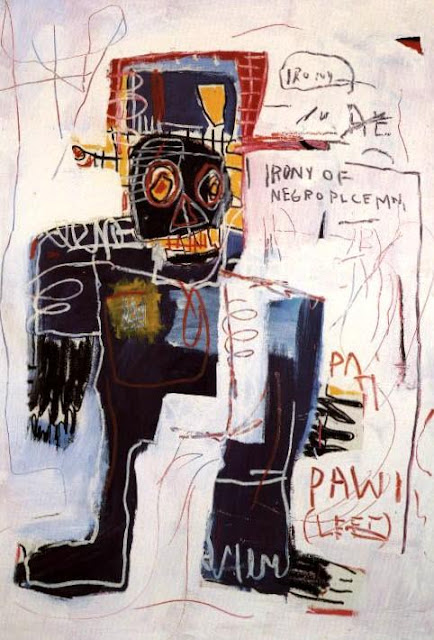50 Years of Black Art in the African Diaspora. A Brief Overview
“The art history of the black diaspora is still an ‘undiscovered’ country,” Kobena Mercer 2009.
Curator, writer and critic Eddie Chambers once described black art as,
“Art produced by black people, largely and specially for the black audience, and which, in terms of its content, addresses black experience.”
A definition which in a so called “Post Black” era, is not relevant to all black artists working today.
The 1960’s
The 1960’s was the decade in which a new black cultural consciousness came into being. The world saw the birth of the civil rights movement and the assassinations of its most famous figure heads, namely Malcolm X in 1965 and Martin Luther King in 1968. In an effort to align themselves with the significant changes that were taking place at the time, there was a shift in the terminology that young African Americans used to describe and identify themselves from “Negro” to the seemingly more assertive “Black.”
An unprecedented increase in the use of the media to report on world issues influenced many artists, causing them to respond to the change in the media landscape in a variety of ways. Jeff Donaldson’s satirical book, The Civil Rights Yearbook 1964, highlighted the power that the media had over public opinion on the subject of race.
In 1966, Andrew Salkey, Edward Kamau Brathwaite and John LaRose established the Caribbean Artists Movement in the UK. Active between 1966 and 1971, the group was created to help form an aesthetic informed by their own cultural heritage and to encourage recognition of West Indian art forms in the UK. The movement went on to inspire many black visual artists to produce work in this vein and included artists Ronald Moody, Errol Lloyd and Winston Branch.
The 1970’s
Many black artists of the 70’s seemed to move towards abstraction. Abstraction provided a medium through which black artists shared their mood and ideals. Artist Jack Whitten acknowledged that being “black” showed itself in his work, without actually being able to define precisely what was black about it. Frank Bowling, a Guyanese born artist, trained in the UK became most known for his controversial essays on the subject of blackness in art, especially his 1971 essay, “Is Black Art about Colour.”
Artists were afraid of depicting black people as nude until the sexual revolution of the 60’s and 70’s because of fears of being accused of being either a racist or pornographers according to Richard Powells, “Black Art A Cultural History.” The historical assumptions of social scientists that black’s were morally depraved contributed significantly to this self censorship. From then on, different artists used the black nude to conceptualise various political and social themes. Artist Dana C Chandler, in his 1971 painting used an erect black male penis, chained and depicted on the inside of a jail cell against the backdrop of a mock American flag to depict his feelings about the anxieties of the black power movement. Artist Faith Ringold examined feminist themes from a personal and political perspective through her depictions of the black female nude.
Artists were afraid of depicting black people as nude until the sexual revolution of the 60’s and 70’s because of fears of being accused of being either a racist or pornographers according to Richard Powells, “Black Art A Cultural History.” The historical assumptions of social scientists that black’s were morally depraved contributed significantly to this self censorship. From then on, different artists used the black nude to conceptualise various political and social themes. Artist Dana C Chandler, in his 1971 painting used an erect black male penis, chained and depicted on the inside of a jail cell against the backdrop of a mock American flag to depict his feelings about the anxieties of the black power movement. Artist Faith Ringold examined feminist themes from a personal and political perspective through her depictions of the black female nude.
 |
| Dana C Chandler. American Penal System. 1971. Copyright Dana C Chandler |
The 1980’s
1980’s was defined as the decade of art institutionalization in the African diaspora and was marked in the USA by the Smithsonian museum purchasing countless works by black artists.
In the UK, the 80’s defined a generation of artists influenced by the many political issues and events, including the 1981 Brixton riots. Artists including Claudette Johnson, Keith Piper, Donald Rodney and Marlene Smith formed the BLK Art group in response to an overriding feeling that despite achieving world wide success, it was difficult for black artists to be accepted at the top of the art establishment. In 1988, Eddie Chambers, one of the founders, curated the landmark exhibition “Black Art: Plotting the Course.” Chambers also worked with Sonia Boyce, a black British multimedia artist whose work referenced race, identity, feminism and contemporary urban culture.
 |
| Keith Piper. The Black Assassin Saints copyright Keith Piper 1982 |
In 1989, the all black exhibition entitled“The Other Story Afro-Asian artists in post-war Britain, shown at the Hayward Gallery, had a significant impact on the scene.
One of the most iconic black artists of the 80’s, Jean-Michel Basquiat, often used words in his neo-expressionist work which incorporated his cultural heritage. One of his most famous works produced in 1981, the “Irony of the Negro Policeman” illustrated the control that wider white American Society had over African Americans at the time.
 |
| Jean-Michel Basquiat Irony of The Negro Policeman. 1981 |
The 1990’s
The 1990’s was marked by the term “Post Black.” A term that curator Thelma Golden claims to have coined with artist Glenn Ligon. The term was used to define an artistic genre, including a group of artists who refused to be defined by their race, yet who examined complex notions of race and racism through their work. The movement was an attempt to include marginalised black artists into the discourse on Western Art History.
Golden went on to further examine the 90’s in the context of mass marketing by stating in an essay that “Artists live in a world where their particular cultural specificity is marketed to the planet and sold back to them.” Various artists produced work in response to mass produced marketing materials depicting racial and sexual stereotypes including African American artist Renee Cox.
 |
| Renee Cox. The Liberation of Lady J and U.B. 1998 Copyright Renee Cox |
British artist Chris Offilli used his work to critically examine black popular culture, using satire to ask serious questions about society, racism and the mass marketing of dumbed down images of blackness as was illustrated in his 1996 piece Afrodizzia.
 |
| Chris Ofili. Afrodizzia second version 1996. Copyright Chriss Offilli |
2000 to Present Day
Today, there has been shift in consciousness among many black artists from producing work which was a visible symbol of the black experience to more conceptual, subtle and complex work, which declares cultural heritage while simultaneously referencing and repudiating the historical injustices associated with it.
Yinka Shonibare uses his work in complicated and challenging ways to examine various notions of identity including what it means to be African, black, British and post modern. Shonibare is known for historical installations of mannequins dressed in so called African print fabrics.
 |
| Shonibare-Scramble for Africa. 2003. Copyright Yinka Shonbare. Image courtesy the artist and Stephen Friedman Gallery, London |
Significant awards have been given to black artists during this time, cementing their place in art history and recognising their contribution to it including Chris Offilli, Steve Mcqueen, Jacob Lawrence, Kerry James Marshall and Robert Colescott.
Black artists have historically used art to voice political and social concerns with little recognition from wider society. Today, they are getting more recognition than ever before and have moved on significantly from Eddie Chambers 1980’s definition of black art, but in the words of Sonia Boyce…
“…Work produced is still regarded and reduced in totality to questions of ethnicity and cultural difference, outside the historical context of contemporary art. We are working towards a time when the work displayed in exhibitions is no longer cordoned off from it’s contemporaries as a separate and marginal area of artistic production.”
Thanks to Sophia A. Jackson for asking me to write this piece for the October Black History Month edition of Lime Magazine. Without her, it would not have occurred to me to write it.
Please comment and add anything you feel I may have missed out of this short piece. This research is by no means exhaustive.
References
Black Art, A Cultural History by Richard J. Powell. Published by Thames and Hudson World of Art 2002
Introduction to Contemporary British Art of Black and Asian Diasporas: focus on the 1980s
Leon Wainwright, Middlesex University, 2002
Variant.org:African And Asian Visual Artists Archive by Sonia Boyce
The latest news in contemporary and modern art in New York, London, Paris and Berlin


